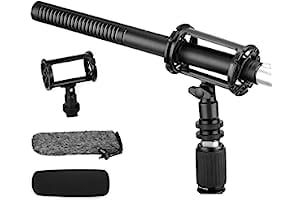Features
RØDE NT1

- Product Type: Microphone
- Package Quantity: 1
- Package Dimensions: 1.0" (L) x 1.0" (W) x 1.0" (H)
- Country of Origin: Australia
BOYA BY-BM6060 Super-Cardioid Shotgun Condenser Microphone

- ❤ The BY-BM6060 Shotgun Condenser Microphone designed for video production and broadcast (ENG/EFP) audio acquisition. Ideal for interviews, independent films, TV programs, documentaries, promo videos and studio recordings.
- ❤ Phantom Power Available: Its 3-pin XLR output is in compliance with 24-48V phantom power supply. When your devices aren't phantom powered the BY-BM6060 microphone can be powered by one AA battery.
- ❤ The BY-BM6060 Shotgun Condenser Microphone focuses on super-cardioid characteristics and resistance to low-noise circuitry noise.
- ❤ Package Content: The shotgun Microphone video Kit comes with a 3-pin XLR microphone, suspension shock mount, fur windshield, foam windshield. The cold-shoe mount with 1/4” thread allows easy mounting on DSLR camera or stand.
- ❤ BOYA WARRANTY: 12 months BOYA Mcrophone warranty and post-sales service, if you are have any questions about our products, please contact us directly.
Introduction
Are you looking for the perfect microphone for your music production, vocal recording, streaming, or podcasting needs? Look no further! In this blog post, we will compare two great microphones: the RØDE NT1 Large-Diaphragm Cardioid Condenser Microphone and the BOYA XLR Microphone BY-BM6060 Super-Cardioid Shotgun Condenser Microphone. We will look at the features, specifications, and benefits of each microphone to help you make the right choice.
RØDE NT1 Large-Diaphragm Cardioid Condenser Microphone
The RØDE NT1 Large-Diaphragm Cardioid Condenser Microphone is a great choice for music production, vocal recording, streaming, or podcasting. It has a large diaphragm capsule that captures sound with incredible clarity and detail. The cardioid polar pattern ensures that the microphone only picks up sound from the front, eliminating unwanted background noise. The microphone also comes with a shock mount and a pop filter for added protection and convenience.
BOYA XLR Microphone BY-BM6060 Super-Cardioid Shotgun Condenser Microphone
The BOYA XLR Microphone BY-BM6060 Super-Cardioid Shotgun Condenser Microphone is another great choice for music production, vocal recording, streaming, or podcasting. It has a super-cardioid polar pattern that ensures maximum rejection of background noise and a wide frequency response for capturing sound with incredible accuracy and detail. The microphone also comes with 24/48V phantom power, allowing you to record with higher-end equipment.
Features and Specifications
When comparing the features and specifications of these two microphones, there are a few key differences to note. The RØDE NT1 has a large diaphragm capsule and a cardioid polar pattern, while the BOYA XLR has a super-cardioid polar pattern. The RØDE NT1 also has a lower maximum SPL than the BOYA XLR. However, the BOYA XLR has the added benefit of 24/48V phantom power, allowing you to record with higher-end equipment.
Benefits
Both microphones offer great benefits for music production, vocal recording, streaming, and podcasting. The RØDE NT1 has a large diaphragm capsule that captures sound with incredible clarity and detail, while the BOYA XLR has a super-cardioid polar pattern that ensures maximum rejection of background noise. The RØDE NT1 also comes with a shock mount and a pop filter for added protection and convenience, while the BOYA XLR has the added benefit of 24/48V phantom power.
Conclusion
When it comes to choosing the right microphone for your needs, both the RØDE NT1 Large-Diaphragm Cardioid Condenser Microphone and the BOYA XLR Microphone BY-BM6060 Super-Cardioid Shotgun Condenser Microphone offer great features and benefits. The RØDE NT1 has a large diaphragm capsule and a cardioid polar pattern, while the BOYA XLR has a super-cardioid polar pattern and 24/48V phantom power. Ultimately, the decision comes down to your specific needs and preferences.
We hope this blog post has helped you understand the differences and similarities between these two microphones. For more information, please visit the official websites of both products: RØDE NT1 and BOYA XLR Microphone BY-BM6060.
Specifications / Attributes
| Feature | RØDE NT1 | BOYA BY-BM6060 Super-Cardioid Shotgun Condenser Microphone |
|---|---|---|
| Batteries | N/A | 1 AA batteries required. |
| Batteries Included | N/A | No |
| Batteries Required | N/A | No |
| Brand | N/A | BOYA |
| Colour | Black | N/A |
| Compatible Devices | Rode accessories | Radio, Amplifier, Speaker, Camera |
| Connector | / | N/A |
| Connector Type | N/A | XLR |
| Date First Available | 3 August 2022 | 3 August 2020 |
| Hardware Platform | N/A | Camcorder, Camera |
| Item Model Number | NT1 4th Gen | BOYA BY-BM6060 |
| Item Weight | 440 g | 230 g |
| Manufacturer | N/A | BOYA |
| Material Type | Aluminium | Foam |
| Microphone format | N/A | Shotgun |
| Model | N/A | BOYA BY-BM6060 |
| Mounting Hardware | N/A | Microphone |
| Noise level | N/A | 80 dB |
| Package Dimensions | N/A | 35.7 x 12 x 7.7 cm; 230 Grams |
| Part Number | N/A | BY-BM6060 |
| Power Source | Corded Electric | Corded Electric |
| Product dimensions | 26.92 x 21.34 x 17.65 cm; 440 Grams | N/A |
| Proficiency Level | Professional | N/A |
| Scale Length | Inches | N/A |
| Signal-to-noise ratio (dB) | N/A | 80 dB |
| Size | 1" | N/A |
| Special Features | N/A | Stand |
| Check the Best Deal Price Today | Check the Best Deal Price Today |







